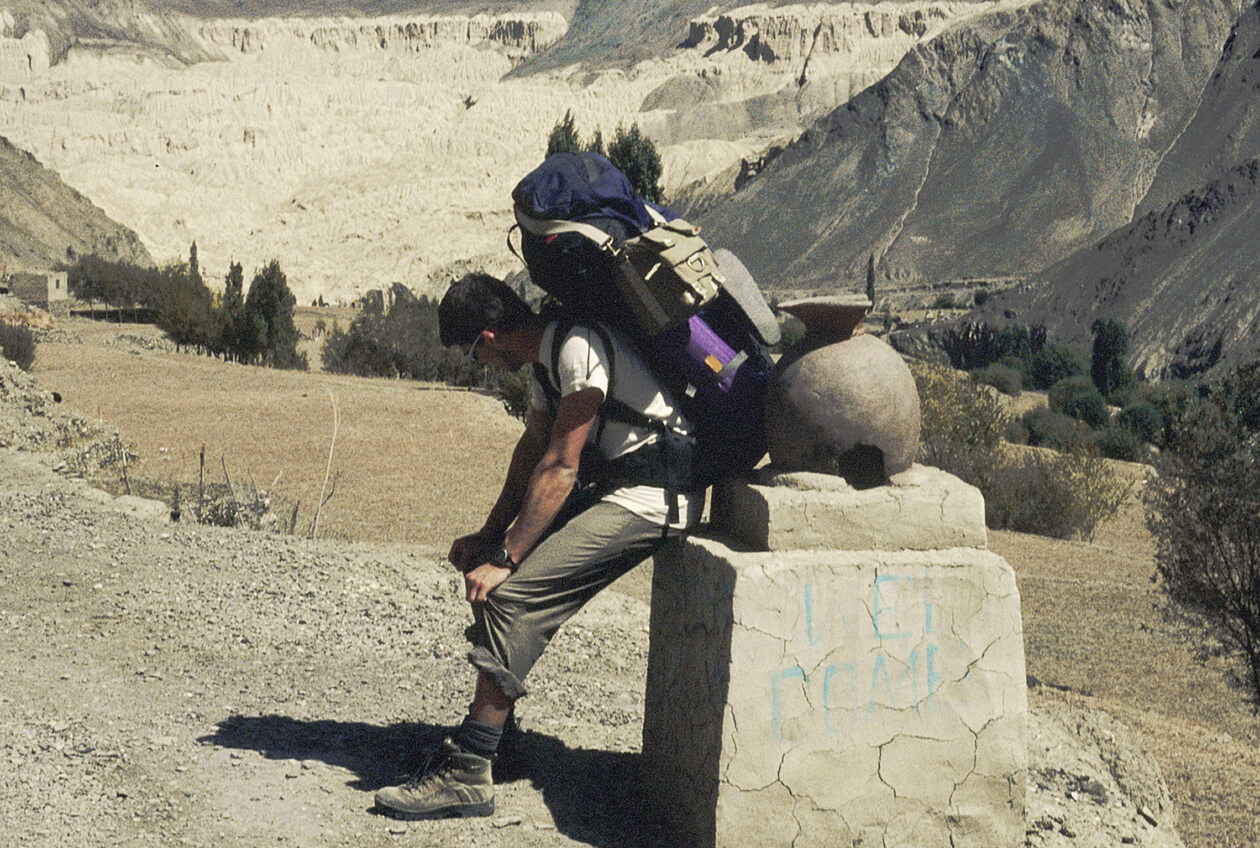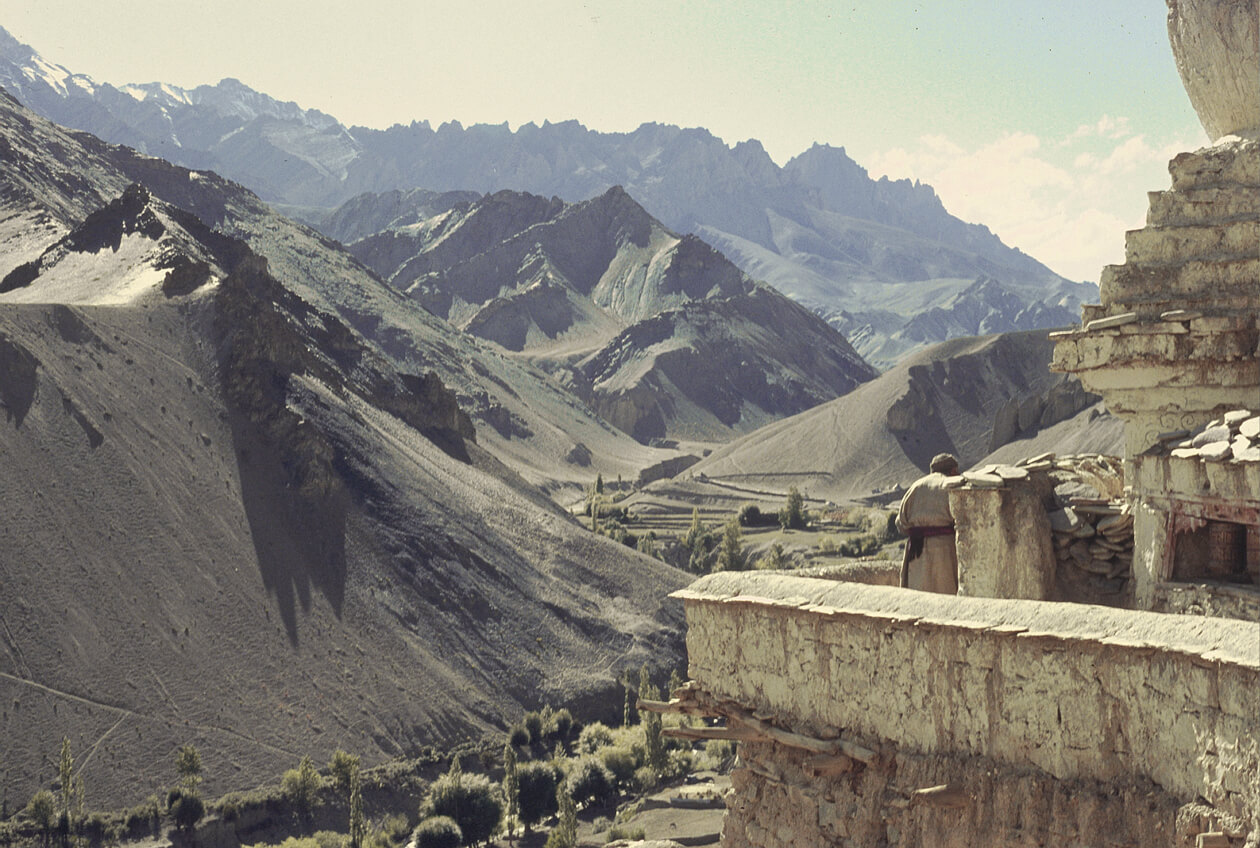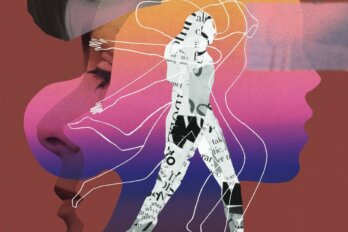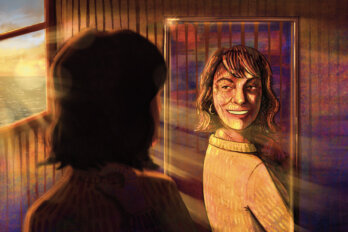I was startled awake by the sound of my father rifling through my backpack at the end of the bed. He was dressed and ready for the day: hiking pants on, down vest zippered tightly over a fleece pullover, toque on his head. Only the untied laces on his boots signalled haste.
My fingers found the light switch in the dark. The guest house room was musty and cramped, with just enough space for two single beds and a side table wedged between them.
“What’s going on?” I asked. He was pulling items out of my backpack and stuffing them into a cardboard box. “We need to lighten our load,” he said without looking up. He was frantically filling the box with non-essentials: clothing for warmer climates, our one book each, a few small souvenirs, two sets of crampons, and a coiled length of rope. “I’ll find a Jeep driver to take it to Leh and mail it home for us,” he said.
In my daze, his plan wasn’t registering. I looked out the room’s small window: the tips of a jagged range of Himalaya were fringed with an orange glow. A new day. We had already tried once to begin our expedition into the mountains and had to turn back. Dad loomed at the end of my bed, waiting. “You want to try again?” I asked.
Three months before, I was trudging home from work through a warm Vancouver rain when my cellphone buzzed in my pocket. Skipping small talk, Dad began with a phrase that he used during nearly every call between us. “So I was just reading this article,” he began, “about this fantastic-looking hike in India. It goes through the Zanskar Range in northern India. You actually take a Jeep into the Himalayas just to get there.” Excitement rang in his voice. “It looks amazing,” he said. “We should go.”
It had been a decade since our first major father-son adventure: walking the routes of Santiago de Compostela in France when I was a young teenager. We meandered through vineyards and hazelnut groves, down forest paths, and in riverside villages. We picked melons from a farmer’s field, drank wine from the bottle, and ate backpack-warmed Camembert poured onto baguettes. We had a simple goal: complete a 700-kilometre walk from the cathedral town of Le Puy-en-Velay in south-central France to the Spanish border in the Pyrenees. And we did it. Une grande randonnée avec mon père. I wanted that adventure again. “Let’s do it,” I said.
Dad had turned sixty-five that spring. Before settling down with my mum to build a house on Salt Spring Island, British Columbia, and raise my sisters and me, he had hiked, climbed, and mountaineered in North America, Africa, and Asia—and even worked as a guide in Europe. I inherited my love of mountains and hills from him and grew up bombarded with tales of his alpine adventures: stumbling into an Italian geological surveyors’ camp after being caught in a snowstorm in Pakistan’s Hindu Kush, photographing big-wall climbers as they scaled the Bugaboos near the Rockies, and navigating high-altitude bogs in central Africa’s Rwenzori Mountains. A favourite photograph of mine is from this range, taken in the summer of 1967: Dad is sporting a brown corduroy blazer over a red turtleneck sweater with plaid pyjama pants tucked into his hiking boots, and he’s standing on a glacier at 4,500 metres with his feet practically straddling the border between Uganda and the Democratic Republic of the Congo. It was a photo I wanted—ridiculous and awesome and triumphant.
Forty years to the month later, I hiked and climbed in the Rwenzoris on my first major mountaineering expedition. I traversed my first glacier, scaled my first peak above 5,000 metres, and returned with my own images and memories. Some were similar to his, such as the tenacity, kindness, and humour of the Bakonzo people. Others were shockingly different—the degree to which the glaciers had receded, for example.
For years, I relished stepping into my dad’s forty-year-old footsteps and appending his stories with forty-year-later footnotes. Our stories became intertwined, with one of us often launching into a tale by starting with the story of the other. Dad had visited India before. In November 1967, he took a multiday boat trip across the Arabian Sea from Mombasa, Kenya, to what is now Mumbai. Then, for half a year, he zigzagged the subcontinent as part of a three-year wander around Africa, South and Southeast Asia, and across the Middle East to Europe.
The trip to the Himalaya would give us another moment to share, but it also presented an opportunity for me to ask him something that had been weighing on me for five years. I knew his life like a movie. I could recount every major scene and setting and plot, except for one: a decade that, for some reason, he had never filled in. It was decade that, as I accidently found out from an old friend of his, altered the plot of his life not dramatically but, in my mind, substantially. It was also a gap in a history that, as a son, I felt entitled to know.
Over the summer, topographical maps of the north Indian region of Ladakh and the Zanskar Valley were like permanent placemats on the kitchen table at home. We hunkered over them, confidently tracing wavy lines with our fingers and marking possible stages for each day. The route would take us through the Zanskar Range, from the monastery village of Lamayuru south to the transit village of Karsha. I bought two guidebooks filled with every detail we needed to navigate our trip.
As our departure date drew closer, we read the history of Ladakh, stocked up on freeze-dried meals, and dusted off our mountaineering gear. We decided on a self-reliant trek of more than two weeks: we would carry our food, tent, and equipment ourselves. I packed my half into a sixty-five-litre backpack, filling every compartment and pocket with some form of sustenance, shelter, and supply.
We spent nearly a week travelling by bus and Jeep from New Delhi to the starting point of our trek through the Zanskar Valley. The village of Lamayuru was little more than a handful of plaster buildings below an eleventh-century Buddhist monastery, or gompa, that clung to a hillside off one of India’s most northern roads. Frequented by Jeeps and trucks, the road was a perennially dusty track along an equally perennially disputed border region where India, China, and Pakistan squabble over the lines that cross mountain and glacier.
I met Dad for breakfast in the leafy courtyard of our guest house. As I sat down, a man in a white undershirt, brown baggy trousers, and plastic sandals three sizes too big appeared carrying two bowls of banana porridge and a pot of milky tea.
It was a morning of encouraging omens for anyone heading into the mountains. But while the crisp air and cloudless skies boded well, I felt nervous. Dad hadn’t been sleeping well during the four nights we spent in Leh, the largest city in the region; he woke often during the night and felt lethargic and struggled with shortness of breath as we explored the city during the day. Our bodies were sore, too, after days crammed into buses and Jeeps that tore over one of the highest motorable passes in the world with staggering recklessness and speed.
“How are you feeling?” I asked.
“Still up and down a bit during the night, but fine,” he replied. His grey beard was coming in after a week without shaving. “You?”
I felt great. We had arrived at the trailhead of a trek that we had planned for months. We were in India at last.

Dad finished his porridge, but I could tell his appetite wasn’t quite as limitless as usual. Across the road, men and women were already working in the terraced fields, winnowing millet chaff and tending their lumbering yak-cow hybrids called dzo. Above us, bells began to toll. It was time to start. We slung our backpacks onto our shoulders and found the livestock track into the valley, over a small brook, and up toward a narrow gorge that cut into the mountains. A boy of seven or eight watched us curiously as we trudged through the fields. He wore a baseball cap with “Xplore India ’08” stitched in white letters and was clutching the reins of a mule—the preferred method of moving weight through these mountains.
A pair of white crumbling stupas, conical monuments that often hold Buddhist relics, flanked the entrance to the gorge and marked the true trailhead. We followed a winding riverbed, dried and cracked by drought, where gnarled trees and hardy scrub bushes eked out an existence in a region cut off from annual monsoon relief.
At the end of the riverbed, the trail hairpinned up towards Prinkiti La, the first of many passes that bisected the trail ahead. Dad went first, and I followed closely behind. In a single step, the path turned from flat to steep. I kept my head down. Step. I could feel the weight on my back through my hips down into my feet. Step. I could see the two peaks that formed the pass above. Step. My breath increased as I tried to suck in air. Step. We just had to get over the first pass. Step. Each of my paces landed in the footprints left in the dust in front of me.
The path levelled for a moment, and with my eyes fixed on my boots, I nearly bumped into the big green backpack in front of me. Dad had come to a halt. I waited for him to adjust his pack and keep going, but he just stared off in the distance—back the way we had come. The moment stretched.
“I’m sorry, Boogie,” he said finally, using my childhood nickname. “I don’t think I can do this.”
I looked up and ahead, where I could almost see the saddle between the mountains. We were so close to the pass. Just one more push and we would be there.
“It’s okay, Dad,” I said, the words separated by heavy breaths.
“I know how much you wanted this,” he answered, still not looking back at me.
“It’s okay.”
I knew this trip was important for him as well: to share the mountains, and another adventure, together. Maybe even show his son that he could still tackle a strenuous, high-altitude trek.
Minutes passed in silence with our feet planted on the trail, our hands on our hips, our toes pointing upward. With each second, I was slowly resigning myself to the fact that it was ending before it had begun. When Dad finally turned, even though his eyes were hidden behind sunglasses, I could tell he was fighting back tears. So was I. The weight was too much. Without another word, he passed beside me and started down the trail.
I looked up to the craggy ridgeline, the stratifications bending and arcing and twisting from a profound geological force that compelled the range into existence. Over millions of years, the pressure between two giant plates of rocks had intensified, building and building, until a new landscape emerged, jagged and raw.
I turned and followed his footsteps out of the mountains.
Dad’s boots were tied tightly in double knots when he returned to the guest house room the morning of our second attempt. He had flagged down a Jeep and paid the driver a few dollars in rupees to deliver the box to Leh. “This is much better!” he said as he adjusted the straps of his now lighter backpack. We were trying again.
With a renewed spring in our step, we trudged down through the farms, across the stream, and up through the two white stupas. The path was familiar—with only the tracks of a mule train having obscured our day-old boot prints in the fine dust. As we started up the switchbacks, I felt a rhythm settle in, a steadying beat that comes from putting one foot in front of the other going uphill: the hiker’s cadence.
We passed the point where we had turned around the day before, and we kept going without saying a word. The pass seemed to come quickly. We stood at the saddle in the ridgeline, a space just wider than the trail, and were welcomed with a panoramic field of broad dagger-like peaks that poked the horizon.
“Beautiful.” Dad didn’t need to say anything else.
We didn’t hug or shake hands or in any way revel in our first small accomplishment. The pass felt bigger, and much higher, than it actually was. We just took a moment to catch our breath and guzzle water, and then we began down the steep trail into the next valley.
At the bottom, we snaked through a narrow, ochre-coloured canyon until it opened up. We followed a tributary of the Zanskar River past the hamlet of Wanla until we reached a copse of willows next to a brook that ran as cold as a glacier. Dad pitched our yellow tent while I boiled water for tea. I busied myself cooking rice to go with our dehydrated curry and stringing up a line to dry our sweaty shirts and socks, while Dad stretched out on his sleeping mat. It was my element, and it was his too.
The next day we were packed up and back on the trail before the sun had crested the peaks above. We soon entered a narrow gorge with only a sliver of blue sky hundreds of metres above and a thundering river below. Around noon, we rested under poplar trees near a cluster of houses built of stone and thatch. A woman appeared, her face lined and leathery. “Jule!” she said, using the Ladakhi greeting, before pressing a few dried apricots into our hands.
Out of the gorge, we left the trees—few as they were—behind. With each hundred metres of elevation gained, the vegetation began to shrink. By late afternoon, we had climbed halfway up a sloping alpine meadow and found a space of flat grass just large enough for our tent. We could see the second pass, the 4,800-metre Sisir La, up ahead.
We set camp and took a stroll around the meadow with cups of jasmine tea. Small white flowers protruding from clumps of grass trembled in the breeze. As the sun dipped behind the looming yet oddly comforting mountain range, I thought about asking Dad about his past. We stood at the heart of a valley, encircled by peaks like the petals of an open flower. Would there be a better time? But he seemed tired, affected by some unseen force, and there would be many days and nights ahead and many better moments to talk.
After dinner, the light faded quickly, and we crawled into our sleeping bags. It took me a while to fall asleep, with a bright full moon illuminating our tent. The air was noticeably thinner: I tried to take calm, deep breaths, but my lungs refused to fill. I eventually nodded off, only to be woken by Dad gasping for breath. I sat upright, startled by the sound. In each full breath, he was trying desperately to pull in air while hacking out a cough. I could hear the pain rasp in his throat.
“You okay, Dad?” No answer. I had asked that question a lot over the previous few days. His appetite had shrunk, which was the most obvious symptom of his body adjusting to high altitude. Unless we descended, there could be a risk of fluid building up in his lungs, a condition called high-altitude pulmonary edema, or of his brain swelling with fluid, known as high-altitude cerebral edema. Both ailments can be fatal. I listened as his coughing subsided and his breathing stretched. It would be too dangerous to try to descend in the dark, so I lay awake and listened.

For the rest of the night, we both slept fitfully, and he was no better in the morning. I crawled out of the tent, jogged on the spot to get the blood moving, then lit the stove to boil water for tea. Two Ladakhi men appeared over a hill to collect the unofficial fee for camping on their land: a hundred rupees, about two dollars.
Dad emerged, and I handed him a cup of tea. We sat on the moss and talked options. This time, the trail split, not into high or low routes but into a choice between pressing on or turning back.
“That sounded bad last night,” I said. The sun was creeping down the mountainside.
He nodded. “I didn’t sleep much,” he said. I knew.
I could see it in the dark under his eyes. “Do you want to head back down to the river, sleep there a night, and then see how we feel?” I asked. Even descending a few hundred metres would help.
“I think we should go back to Lamayuru,” he said quickly. “I’m sorry.”
I could tell by the way he looked at me that he could see the colour and the excitement drain from my face. It couldn’t be over. Not again. Why had I thought the first pass was the hardest hurdle?
“What do you want to do?” he asked before asking a question he didn’t want me to answer. “Do you want to go on without me?”
We exchanged few words over the two days back to Lamayuru. Dad walked thirty metres ahead of me, or maybe I kept thirty metres back. It seemed as if he couldn’t get out of the mountains fast enough, while I wanted to stretch the time out as far as I could. He stopped once along a river and stepped off the trail. I watched him raise his old Nikon film camera to his eye and take a photo.
When I reached the same point, I saw what had caught his eye: a woman washing rugs in the rushing water and laying them out to dry, the bright colours and patterns in stark contrast with the drab rocks. I pulled out my camera and looked through the viewfinder. My finger hovered above the shutter, but then I lowered my camera and put it back in my bag.
The two white stupas appeared more quickly than expected. To enter the mountains takes forever; to leave them takes an instant. I almost expected Lamayuru to have changed when we walked down into the valley. The same farmers worked in the fields, the same dzo grazed, and the bells still rang from the gompa. I looked for the boy and his mule. When I reached the road, I slumped onto a concrete barrier, hands on my knees, panting, to take the weight off my back. I heard the shutter of his camera fire.
We dropped our packs back in the same musty guest house room. “Let’s walk up to the monastery,” Dad said immediately.
The gompa was made of a dozen or so buildings painted red and white and connected by prayer flags like telephone wires laden with electricity. Near the main temple, we sat on a low stone wall that overlooked the village, and we stared across the valley to the mountains that had defeated us. Muffled chants and bells echoed out the monastery doors, seemingly carrying wafts of burning juniper from the temple braziers with each ring. Below, a group of young monks in maroon robes played cricket on a makeshift pitch, their bare feet kicking up puffs of fine ochre dust.
What felt like an hour passed before either of us spoke. I knew Dad could tell I was disappointed, but he had no idea why. It wasn’t just a failure to complete a trek. Questions raced through my thoughts. Which one first? Where should I begin?
I opened my mouth and heard his voice.
“What’s the most important thing in travelling or mountaineering or…” he asked, the word “life” hanging in the air unsaid. It felt like he had been mulling over both question and answer during the long walk back to Lamayuru.
I had my answer in an instant but took a moment to respond. “To be flexible,” I said finally, not exactly what I meant. “Some things aren’t going to work out.” It was the answer he wanted, not the one I wanted to give. He was putting me on the spot and asking me to accept a failure and move on. He just didn’t know why I felt like I had failed. I could see on his face that our time in the mountains had been hard on him too—he was confronting a history of boundless exploration and being forced to turn back.
Dad kept looking straight ahead, across the valley, and spoke about how the paths we choose don’t always have to end in accomplishment. I looked across the valley to trails uncompleted, mountains unclimbed, questions unanswered, and I tucked my hands under my thighs to keep them warm, the way I used to when I was a kid. I glanced up to the white wisps of cloud that tore across the sky and hoped the wind would dry my eyes.
I shivered at a cold gust. My mouth was parched. Dad patted me on the shoulder and left me sitting on the rock wall. From periphery to periphery my eyes were filled with mountains. I blinked from peak to peak and my questions dropped into the valley below. It didn’t matter anymore. We had tried. I had tried. And he had given me answers, just not the ones I set out to find. His history was his own—to confront, to manage, to share—and so was mine. We had left Zanskar the way we came, this time leaving a couplet of distinct footsteps in the fine dust.
The wind settled around the monastery, and the smell of juniper grew stronger. A monk in flowing robes, his head shaved, appeared from behind a temple. With one gnarled hand, he swung a brass incense burner while delicately fingering prayer beads with the other. His chant grew louder as he neared and passed behind me: “Om mani padme hum. Om mani padme hum. Om mani padme hum.…” He was reciting a Sanskrit mantra: the jewel in the lotus flower. He glided behind me a second time, completing a ritual circumambulation of the temple called a kora, then a third time, then a fourth—going nowhere but in circles.
The monk’s slippered feet shuffled on the smooth cobblestones once again as he made another circle. I got up and followed him around, his chant like the deep rumble of faraway thunder.
This article was written with the support of the mountain and wilderness writing program at the Banff Centre.




